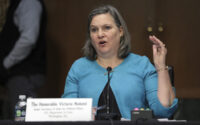Bond Market Suffers Worst Quarter in Decades
U.S. bonds’ worst quarter in more than 40 years has come to a close. The question for many investors now is whether it is time to buy the biggest dip in recent memory.
The Bloomberg U.S. Aggregate bond index—largely U.S. Treasurys, highly rated corporate bonds and mortgage-backed securities—returned minus 6% in 2022 through Wednesday, on track for the biggest quarterly loss since 1980.
Yields on short to medium-term Treasurys—which rise when their prices fall—have logged their biggest quarterly gains in decades, with the two-year yield rising the most since 1984 and the five-year yield the most since 1987.
The poor performance of bonds has robbed investors of a traditional haven at a time when stocks and many other markets have been swinging sharply, thanks to factors including the Federal Reserve’s first interest-rate increase since 2018 and the war in Ukraine.
Yields on Treasurys largely reflect expectations for what short-term interest rates will average over the life of a given bond. Investors dramatically increased those expectations over the past three months—driving bond prices down and yields up—thanks to a run of high inflation readings and Fed officials sounding ever more concerned about that data.
Over the longer term, higher rates could slow inflation and possibly even drive the U.S. economy into recession, which would be better for bonds than most other assets. Meanwhile, however, some analysts warn that rate expectations could keep heading higher, driving further losses for bonds.
Tom Graff, head of fixed income and portfolio manager at Brown Advisory, said he generally doesn’t expect much more gains in longer-term yields. Shorter-term yields, he said, could easily climb further as the Fed keeps raising its interest-rate forecasts.
“A lot of money has been lost in the bond-trading world betting on Fed peak hawkishness,” he added.
As it stands, interest-rate derivatives show that investors now expect short-term rates to reach 3% next year—up from less than 0.5% now and near zero before the Fed’s recent move.
Still, investors also expect rates to come back down quickly after reaching that level. Embedded in that view is a continued belief that inflation—now running at a 40-year high at 7.9% by one measure—will subside largely on its own as businesses increase the supply of goods and consumer spending slows due to the fading effects of emergency government-spending programs. Many investors also doubt the economy can handle 3% interest rates without slowing significantly.
As a result, yields on some shorter-term Treasurys, such as the three-year note, have edged above those of longer-term bonds like the 10-year note—creating what is known on Wall Street as a flat or inverted yield curve.
By contrast, some economists on and off Wall Street have argued that rates are likely to go much higher than 3% because nothing less will be able to fix the inflation problem.
The yield on benchmark 10-year U.S. Treasury note settled Thursday at 2.324%, up from 1.496% at the end of last year and the record closing low of 0.501% early in the pandemic when investors thought it would take many years before the Fed would raise interest rates again.
Unfortunately for fund managers, the longer they waited to adjust their expectations, the more painful it became to do so.
In general, slowly rising bond yields are a “fantastic environment for bond investors” because it allows managers to use the cash flow from interest and principal payments to buy new bonds with higher yields, said Vishal Khanduja, fixed-income portfolio manager at Morgan Stanley Investment Management. However, a large rise in yields—and drop in prices—over just a few months makes it impossible to absorb losses that way.
Copyright ©2022 Dow Jones & Company, Inc. All Rights Reserved. 87990cbe856818d5eddac44c7b1cdeb8
[ad_2]
Source link


